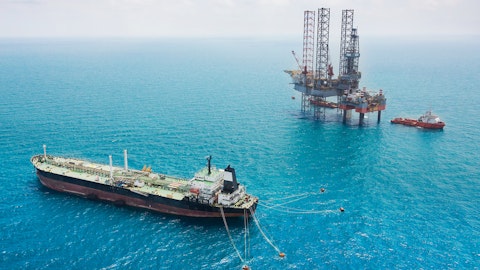Mads Peter Zacho: Oeyvind, why don’t you give a few words to that one?
Oeyvind Lindeman: Yes, of course, Omar, the very large gas carriers dropped off a cliff earlier in the year. That did not happen with the handysize segment. Contrary, it increased, both in the broker assessments that we show every earnings call, but it filtered through to the rates that we were able to renew at or some of the ethylene — ethane spot fixtures. So, we did not experience the same as the VLGCs where it was positive for us and remains positive.
Omar Nokta: Okay. Thank you. And then I guess maybe just perhaps maybe for you, Randy, or just for everyone, just in terms of the terminal expansion, thinking about the contracts that could be entered into, how do you envision those starting to develop as we move through ’24? Do you think that there is — you obviously have the existing nameplate capacity with a big chunk of that 1 million contract, 1 million tonnes. But for the expansion part, there’s a 550,000 tonnes that are coming on. Do we think of — is that where we can see contracts coming? And then also, what about contracts for the potential upwards of, say, the extra 1.5 million? Does that become contracted also this year? Or is it more of a spot?
Randy Giveans: Yeah, Omar, I’ll start on that. So in terms of the scale of contracting, clearly, we have the 94% on the existing 1 million contracted, but those unwind over the coming years. So, we expect some extensions there. And then, for additional new contracting, we expect that to happen, frankly, this year. So, when you look at it as a portfolio, we’ll have about 1.55 million tonnes that we can sell forward starting January 1, 2025, let’s call it. The plan, the goal is to sell probably 90% of that forward. I think that’s the enterprise and Navigator model for this asset. So, that would be 1.4 million tonnes roughly, that we’d want to have sold in advance, right? And we think the first few of these contracts, both on the upsized extension, new customers, should be happening here in the coming weeks, months at the latest.
So that’s kind of your first part. In terms of contracting additional tonnage, for now, we are guaranteed the 550,000 tonnes from the new train, the Flex Train that can do up to 2.2 million tonnes in addition to the million that we already have. Now, in terms of contracting that, we cannot contract that forward because we are not guaranteed that capacity. Now maybe in future years, we will start buying additional guaranteed capacity per se. But for contracting purposes, the most we could sell forward is 1.55 million tonnes and then incremental cargoes would be then sold on a spot basis.
Omar Nokta: Okay. Thanks, Randy. That’s a — okay. That is very, very clear. Final one for me, and I’ll pass over. It is a separate topic, but something you guys have highlighted for several quarters now, and that’s the ammonia trade as an area of growth, and you guys are very active in that already. And you mentioned recently seeing a good amount of cargoes there. We have seen owners in the shipping segment kind of — or shipping side to kind of go after the VLACs as a way to capitalize on this trade going forward over the long term? I guess, one, is that something that Navigator has an interest in to explore the larger ammonia carriers? And then — or do you think that perhaps ammonia is more easily or realistically shipped on the midsize and smaller ships that you currently operate?
Mads Peter Zacho: Maybe I can just kick us off on this and then I’ll invite my colleagues to add to it. We think that the majority of ammonia in the future is going to be transported on midsize. They’re very flexible, and they’re very well suitable for ammonia trade. It’s not very expensive for VLGC owners today if they want to order a new-built VLGC to add, you could say, a small cost on to that and then make it capable of transporting ammonia. So, you could say it’s not — I don’t think necessarily you should assume that these VLGC owners necessarily expect that they will be transporting ammonia on those new build orders that they put in. When it comes to our view on it, we are talking to a number of customers around this, and we do expect that over time, we’ll be building vessels that being handysize or midsize vessels that will be carrying ammonia.
For now, we would probably be looking to do it against an offtake contract so that we have, you could say, at least the first couple of years covered particularly if it comes to building vessels that are propelled also by ammonia. So, we do expect to take part in this market. We also expect to take part in the wider supply chain. Azane Fuel Solutions is a good example of that. And we think also upstream replicating a setup like we have with enterprise today on Morgan’s Point for ethylene, if we can do something similar on production of ammonia or the marine logistics around it, would be quite interested in doing so.




